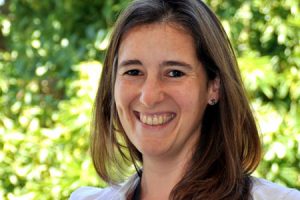Mariana studied Physics (UBA) and Materials Sciences (CNEA-UNSAM), she pursued a specialization in Processing Techniques of Plastic Materials (INTI-UNSAM) and then she worked as a R&D Scientist at TENARIS Siderca prior embarking in a master in Bioengineering at the Politecnico di Milano (Italy). In November 2009, Mariana obtained a Ph.D. in Chemistry (Leibniz IPF; cell-material interactions, biofouling) granted by the TU Dresden (Germany) after which she worked briefly at the Laboratory of Biopolymers (Brandenburgischer TU, Germany) developing a paper-based sensor. Two postdocs followed: one at the Microfluidics Lab (Northeastern University, USA) and another one at the LPEM (ESPCI, France); the first dedicated to the design of microchips for proteomics and for rare cell separation and the second one aiming at developing biofunctional quantum dot nanoparticles for biomedical applications.
Mariana also has four-year teaching experience as a university TA in Mathematics II and Applied Chemistry at the UTN Delta, to which practical scanning electron microscopy courses are added (ESPCI). Mariana has contributed to the scientific training and education of grad and undergrad students in various countries. She has also participated in dissemination and outreach activities organized by the European Union and in a series of talks addressed to college students.
Research interest
Surface physico-chemistry
Surface (bio)functionalization
Control of unspecific interactions (biomolecules adsorption, cellular adhesion)
Cell-material interactions
Sensors for medical diagnosis
Microfluidics for proteomics
Surfaces for the selective capture of rare species/cells
Quantum dot nanoparticles for medical diagnosis and for applications in molecular biology (single-particle tracking)
Super-resolution microscopy coupled to biofunctional quantum dots for the evaluation of neuronal plasticity and its relationship to neurogenesis
Nanoparticles’ clusters for applications in (bimodal) detection of rare events
Celular toxicity of nano/micromaterials
Selected publications
- “Sulfobetaine‐vinylimidazole block copolymers: a robust quantum dot surface chemistry expanding bioimaging’s horizons”; Mariana Tasso, Emerson Giovanelli, Diana Zala, Sophie Bouccara, Alexandra Fragola, Mohamed Hanafi, Zsolt Lenkei, Thomas Pons, Nicolas Lequeux. ACS Nano 9(11), 11479–11489, 2015.
- “Oriented bioconjugation of unmodified antibodies to quantum dots capped with copolymeric ligands as versatile cellular imaging tools”; Mariana Tasso, Manish K. Singh, Emerson Giovanelli, Alexandra Fragola, Vincent Loriette, Marie Regairaz, François Dautry, François Treussart, Zsolt Lenkei, Nicolas Lequeux, Thomas Pons. ACS Advanced Materials and Interfaces 7 (48), 26904–26913, 2015.
- “Multimodal Mn‐doped I‐III‐VI quantum dots for near infrared fluorescence and magnetic resonance imaging: from synthesis to in vivo application”; Gary Sitbon, Sophie Bouccara, Mariana Tasso, Aurélie Francois, Lina Bezdetnaya, Frédéric Marchal, Marine Beaumont, Thomas Pons. Nanoscale 6, 9264–9272, 2014.
- “Immobilized enzymes – valuable tools for the indication of temperature events”; Stefanie Wetzel, Peter Allertz, Sören Koschnicke, Mariana Tasso, Katrin Salchert. Biocatalysis and Biotransformation 31(2), 100–113, 2013.
- “Active enzyme nanocoatings affect settlement of Balanus amphitrite barnacle cyprids”; Mariana Tasso, Sheelagh L. Conlan, Anthony S. Clare, Carsten Werner. Advanced Functional Materials 22(1), 39–47, 2012.
- “Antifouling potential of Subtilisin A immobilized onto maleic anhydride copolymer thin films”; Mariana Tasso, Michala E. Pettitt, Ana L. Cordeiro, Maureen E. Callow, James A. Callow, Carsten Werner. Biofouling 25(6), 505–516, 2009.



